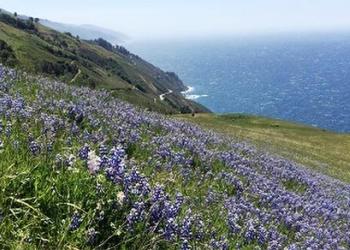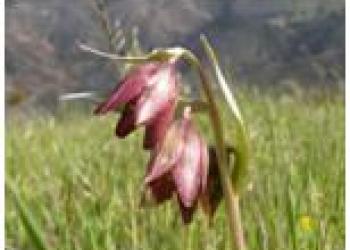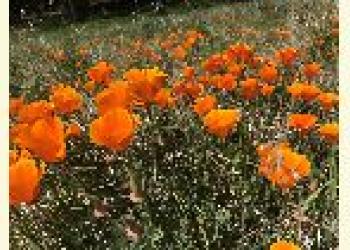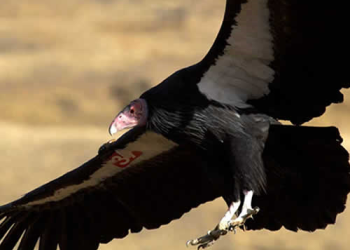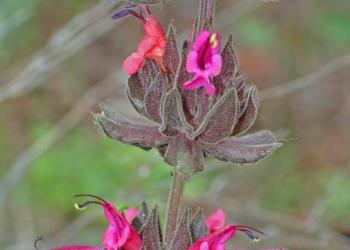Animals and Plants
Los Padres contains a wide range of ecosystems, from seacoast and marine habitats to redwood forests, mixed conifer forests, oak woodlands, grasslands, pinyon juniper stands, chaparral and semi-desert areas, which are home to more than 468 fish and wildlife species. There are twenty-three threatened or endangered wildlife species, twenty regionally sensitive wildlife species and thirty-four forest-level sensitive wildlife species in Los Padres. Los Padres provides habitat for and is involved with the reintroduction of California condors, bald eagles, peregrine falcons, tule elk, bighorn sheep and many endangered plants (there are more than thirty species of sensitive plants in Los Padres).
Los Padres National Forest encompasses an area of 1,752,400 acres, or over 2700 square miles, of habitat ranging in elevation from sea level along the Monterey Coast to 8,831 feet atop Mt. Pinos, the highest point within the forest. Most of the forest is composed of steep, rugged coastal mountains containing watersheds which supply nineteen reservoirs. The major mountain ranges within the forest are the Santa Lucia, La Panza, San Rafael, Santa Ynez and Sierra Madre. The climate varies from Mediterranean along the coast and portions of the interior (cool mild winters and hot dry summers) to semi-desert in the eastern badlands. The coastal areas are often tempered by fog and marine air masses resulting in very moderate, year round temperatures. Rainfall averages seven to nine inches in Cuyama area to between 15 and 30 inches throughout the interior. The Monterey District ranges from 20 inches inland up to 80 inches along the Coast Ridge. The vast land area, and the elevational and climatic factors, play a major role in the diversity of habitat types found on Los Padres.
The varied habitats and topography of Los Padres provide permanent or transitory refuge for some 468 species of fish and wildlife making it one of the more diverse National Forests in California.
Big Game
Currently there are five big game species in or immediately, adjacent to Los Padres: mule deer, black bear, wild boar, Pronghorn Antelope and Tule Elk.
Deer
Mule deer, represented by two subspecies, the Columbian black-tailed deer and the California mule deer, constitute the vast majority of the big game. The deer population is divided among seven deer herds. The black-tailed deer are a more coastal specie. The remaining deer in the San Rafael, Santa Barbara, Ventura and Mt. Pinos herds are comprised primarily of California mule deer.
Bear
Black bear populations have maintained or increased their numbers over the past few decades although very little information is available concerning the central coast area. Areas of high bear concentration include the Santa Cruz and upper Santa Ynez drainage on, the Santa Barbara District, the Sespe Condor Sanctuary, Aqua Blanca and Upper Piru areas of the Ojai District and Sisquoc River area of the Santa Lucia District.
Wild Pigs
The European wild pig is an introduced species which has been present on the Monterey District since 1927. The original European stock was released in the Carmel Valley and has dispersed and intermixed with feral pigs down the coast range into San Luis Obispo County. The major concern with the wild-feral pigs is their destructive nature in sensitive wetland and riparian habitats and their direct competition with wildlife, especially deer, for food and cover in the fall. The feral pig populations have also appeared on the Santa Barbara District in recent years but only in small numbers.
Elk
The Tule Elk, a species historically found on the forest, has been reintroduced onto the oak-grassland areas of the Fort Hunter-Liggett Military reservation immediately adjacent to the Monterey District. The Tule Elk occurred on the forest but was eliminated in the early part of the century due to over hunting and land use changes. Concerted efforts to reintroduce Tule Elk in the Los Padres National Forest were initiated in 1983, with a small reintroduction in the Avenales area. Transplants in 1985 and 1989 of over 120 animals in the eastern portion of the Santa Lucia District and on adjacent private lands, have been successful. This new herd, known as the Pozo Herd, now numbers over 600 elk and has been opened to limited hunting in the past few years.
Antelope
Pronghorn Antelope is another species of historic occurrence on the eastern side of the forest and within the Carrizo Plain. This species also disappeared along with the Tule Elk. Similar reintroduction efforts have been successful and the herd has reached a size allowing limited hunting.
UPLAND GAME
There are seven major groups of upland game which occur on the forest: quail, rabbits, tree squirrels, band-tailed pigeons, dove, turkey and chukar. Quail, both mountain and valley, are found throughout the forest at all elevations, although the Mt. Quail are generally found at higher elevation and are less numerous. The valley or California quail receive the most hunting pressure of any upland species on the forest with the majority of hunting occurring on the Mt. Pinos District. As water seems to be the limiting factor for these birds, over 100 guzzlers have been installed on the forest to help enhance their populations.
Rabbit hunting for brush, cottontail, and blacktail jackrabbits is generally overlapped with upland game bird seasons. Except for the Mt. Pinos District, few areas of the forest afford access to good rabbit country. This has kept rabbit hunting to a minimum on Los Padres. Tree squirrels are another group which have received little hunter pressure. Although the Monterey District offers the best opportunity, there is only minimal hunting pressure. There is no open season for squirrels on the forest outside of Monterey and San Luis Obispo Counties.
Band-tailed pigeons are probably the second most sought after species on the forest during their winter migrations down the coast stopping to forage in the oak woodlands and pinyon pine stands. Some resident populations occur in oak woodlands of some of the coastal portions of the forest with perennial water supplies. These pigeons favor pinyon nuts but in poor pinyon years will shift to acorns, toyon or madrone berries where abundant. The Monterey and Santa Lucia Districts tend to have the greatest harvest with major hunting areas on the coast ridge in Monterey and oak-woodlands of the Santa Lucia district.
Dove populations are generally low on the forest with the primary habitat occurring on the Mt. Pinos District. Generally low seed crop densities and a lack of flat open area limits dove habitat.
Chukar is another introduced species which has only a marginal population in the Mt. Pinos Ranger District of the forest. Additional plantings along with water developments could improve the numbers of Chukar.
Turkey populations in Los Padres currently average around 300-500 birds. This small population is constituted primarily of the outer edge of dispersals from populations planted on adjacent private lands starting in the l940's. The generally poor success of those transplants are believed to be due to the poor adaptability of the hybrid Merriams-domestic stock used and the small numbers transplanted. More recently transplants conducted in the Santa Barbara County portion of the Santa Lucia District, using Rio Grande subspecies, have been relatively successful with good production of young birds in the past few years. Added transplants are planned for this and other suitable habitat areas on the forest.
Waterfowl populations on Los Padres are very limited in both numbers and species diversity due to the limited habitat available and in being out of the mainstream of the Pacific flyway. Due to this very limited supply, waterfowl hunting is essentially nonexistent. Since the development of large reservoirs and good food supplies is not within the foreseeable future, there is little chance that future populations will be enhanced.
NONGAME
The vast majority of wildlife species in Los Padres National Forest are nongame animals. There are some 307 species of birds, 70 mammals, 34 reptiles and 14 amphibians which constitute this nongame group.
Marine Birds and Mammals
Included among the non-game group are the marine birds and mammals which occur along the coastal area of the Monterey District. Included in the group are the sea lions, seals, sea otters and various dolphins and whales which travel within the near shore waters and such seabirds as western gulls, cormorants, pigeon, guillemots, and various shorebirds. Although little can be done by the forest to directly manage habitat for these species it may at times be necessary to restrict public use of some sensitive coastal areas such as some of the coastal rocks used as breeding sites by seabirds or haul out areas by the seals or sea lions. Included in this marine group are such threatened or endangered species as the sea otter and brown pelican.
Los Padres National Forest is one of the most botanically diverse National Forests in the United States. It lies primarily within the Coast and Transverse Mountain Ranges. These mountains have been formed by the intense folding, fracturing, and faulting of the underlying bedrock which has been found to be around 200 million years old, and in some cases, as old as 1.7 billion years. Most of the forest experiences a Mediterranean climate characterized by cool, wet winters and hot, dry summers. Precipitation, consisting of both rain and snow, falls primarily between November and April with annual totals averaging from 8 to 38 inches on the lower four districts and as much as 75 inches on the Monterey District. This climate coupled with elevational changes creates a unique assemblage of plant communities in which chaparral dominates, yet also offers a tremendous diversity ranging from pinyon-juniper woodland to coastal redwood forest. Examples of other plant communities encountered on the forest include conifer forest, riparian woodland, oak woodland, grassland, and sub-alpine fellfield. Of particular interest is a group of specialized plants that grow only on serpentine soils; a nutrient poor substrate not suitable for most plants.
CHAPARRAL
Chaparral is a surprisingly complex plant community. It includes many species of manzanita, chemise, wild lilac, scrub oak, silk-tassel bush, mountain mahogany, islay, monkeyflower, toyon, laurel sumac, current, buckwheat and true sages. Chaparral plants characteristically have moisture conserving leaves, small and thick with either a hairy or waxy covering, and a large root system. They also tend to produce large amounts of terpenes and oils which make them aromatic, and fire prone. Interestingly, chaparral plants actually flourish after fires either by resprouting from basal root burls or growing from seed that germinate only after exposure to high temperatures.
Also noteworthy, chaparral harbors more rare plants than any other plant community found on the forest. The manzanita genus alone accounts for five rare species: Little Sur manzanita, Santa Margarita manzanita, Santa Lucia manzanita, La Cruz manzanita, and Refugio manzanita. Other examples of rare plants include the "late-flowered" mariposa lily", Nuttall's scrub oak, Fort Tejon woolly sunflower, Rockcreek broomrape, Arroyo Seco bush mallow, Carmel Valley cliff-aster, and Ojai fritillary.
PINYON-JUNIPER WOODLAND
Pinyon-juniper woodland occurs primarily on the Mt. Pinos Ranger District. It exists in the most hostile of climates; experiencing snow and bitter cold in the winter, and dry, scorching heat in the summer. In general, pinyon pines occupy the cooler north-facing slopes. Pinyon pines are known for their large flavorful and nutritious nuts which were once a staple food for many Native Americans. Junipers tend to dominate on the south-facing slopes. Other plants found in this woodland include Great Basin sagebrush, rabbitbrush, blackbrush, scrub oak, matchweed, and valley cholla. Although deceptively barren, this community provides abundant food and shelter for many animal species: from the rare blunt-nosed leopard lizard to big horn sheep. (It also provides habitat for many rare plant species including the California jewelflower, Blakley's spineflower, Hoover's eriastrum, Kern mallow, and pale-yellow layia.
REDWOOD FOREST
Coastal redwoods are the tallest trees in the world, some reaching heights of over 350 ft. Redwood stands occur on the Monterey District and represent the southern extreme of the temperate rain forest that occurs along the coast from Alaska to California. Due to their relative isolation, these stands may possess unique genetic material separate from their more northern counterparts. These southern redwoods appear to be restricted to areas which receive ample rainfall and summer fog, primarily along canyon bottoms and north-facing slopes. Other plants associated with this community include California bay, California huckleberry, tanbark oak, poison oak, redwood sorrel, western trillium, false solomon's seal, California polypody, and sword fern. Rare plants include Hutchinson's larkspur and Dudley's lousewort.
CONIFER FORESTS
Conifer forests occur on all five Ranger Districts at the higher elevations on cool, wet north-facing slopes and canyon bottoms. This community consists of pure and mixed stands of Jeffrey pines, ponderosa pines, sugar pines, knobcone pines, Coulter pines, white firs, bigcone Douglas firs, and Santa Lucia firs. Coulter pines produce the largest cones with some reportedly bigger than basketballs. Of course, it is best to avoid pitching a tent beneath these trees! It has been postulated that Coulter pines demonstrate less drought tolerance than other conifers in southern California. Consequently, apparently weakened by drought and smog, many Coulter pines have succumbed to bark beetle infestations. Bigcone Douglas firs, while related to the northern Douglas firs, occur only in southern California extending from Santa Barbara to San Diego. They grow in relatively steep inaccessible north-facing drainage.
Santa Lucia firs are the rarest and most unusual firs in North America, existing along the coast only in Monterey County. These beautiful firs grow primarily on steep, rocky slopes and in canyons.
RIPARIAN WOODLAND
Riparian woodland is one of the most productive and diverse plant communities in the forest. Dense thickets of willows, alders, cottonwoods, sycamores, sedges, and rushes attract a myriad of animals seeking water, food, and shelter. Unfortunately, throughout the west, much riparian woodland has been lost to urban and agricultural development. Consequently, it has become extremely important to protect the riparian woodland still existing on the forest.
OAK WOODLAND
Visitors to the forest will observe woodlands composed of pure and mixed stands of blue oaks, valley oaks, coast live oaks, interior live oaks, and canyon live oaks. Blue oaks tend to grow on drier slopes and form a more open canopy. Canyon live oaks grow in moist drainages and form a closed canopy. Valley oaks, coast live oaks, and interior live oaks all grow under a variety of conditions forming both open and closed canopies. Oak acorns once provided a major food source utilized by Native Americans. Deer, squirrels, bears, birds, and other animals also eat acorns and depend on the woodlands for shelter. Unfortunately, much like riparian woodlands, oak woodlands have been lost to urban and agricultural development. To compound the problem, blue oak and valley oak regeneration appears to be declining.
GRASSLAND
Native grassland once covered California's Central Valley and the valleys of the Coastal Ranges. In fact, the Central Valley was once considered the "Serengeti of North America". However, over the past century, native grasses have been dramatically replaced by farmland and European annual grasses (accidentally and purposely introduced). Some of the native species include needle grass, melic grass, and wild rye. These grasses still exist in scattered locations throughout the forest. Some of the annual species include wild oats, barley, and ripcut brome. These species presently dominate the forest grassland. Wildflowers grow among the grasses, and with the right combination of rain and temperatures, provide exquisite displays of color; attracting many visitors to the forest each Spring.
SUB-ALPINE FELLFIELDS
This community occurs at elevations above 8,000 ft. on the Mt. Pinos Ranger District. Fellfields can be characterized as undulating flats and gentle slopes covered with rock or gravel. Harsh cold winds and snow restrict the majority of plant life to small, ground-hugging perennials. In summer, small flowers bloom in abundance to attract pollinators. Interestingly, because of the short growing season at these high elevations, production of flower buds commences during the year prior to blooming. Limber pines also grow in this community; their gnarled twisted trunks towering above the carpet of perennials.
SERPENTINE PLANTS
Serpentine soils occur in scattered locations on the Monterey, Santa Lucia, and Santa Barbara Ranger Districts. These soils have a high magnesium content and a low calcium content. Most plants cannot tolerate this rare chemical composition. Of those plants that have adapted, several grow exclusively on these soils. Examples include Sargent cypress, leather oak, Santa Barbara jewelflower, Cuesta Pass checkerbloom, and Brewer's spineflower. These rare species also appear to be adapted to fire to the extent that fire suppression may actually cause a decline in the number of plants. For the primary purpose of protecting and properly managing this unique plant community, Los Padres National Forest has established three botanical areas (the forest has a total of six botanical areas). The forest welcomes the public to visit, enjoy, and learn about these fascinating areas.
The location of Los Padres, at the juncture of at least three major ecological regions and the marine coastline has resulted in the forest having the largest number of threatened, endangered or sensitive species of wildlife within the National Forests of California.
The forest provides habitat to many sensitive, threatened or endangered species, such as the California Spotted Owl, Southwestern Pond Turtle and California Leaf-nosed Bat, Least Bell's Vireo, Southwest Willow Flycatcher, Peregrine Falcon, Bald Eagle, Red-legged Frog, Arroyo Southwestern Toad, San Joaquin Kit Fox, Smith's Blue Butterfly, South-Central Coast steelhead, and the three species of listed fairy shrimp (conservancy, longhorn, and vernal pool).
The forest participates in a number of interagency recovery programs for these species. The Bald Eagle and Peregrine Falcon programs have been very successful to the point where these species are in the process of down listing or delisting altogether.
Reintroduction of captively-reared California Condors is one of the more active programs currently operating on the forest. There are 57 California Condors in the wild in in Los Padres National Forest, as of August 2005, where in March 2004 there were 39. There are also California Condors in the wild in Arizona and Baja California. As of August 2005 there are 55 in Arizona and 13 in Baja. These numbers fluctuate on a regular basis.
Contact Patrick Lieske, Forest Wildlife Biologist, or contact US Fish and Wildlife, Condor Recovery Program Office in Ventura, CA.
The following is a list of ferns, conifers, and flowering plants that occur on the Mount Pinos summit above the 8,500 foot elevation contour. The Chula Vista Campground and parking lot are located at about 8,500 ft.
This list, prepared by the Mount Pinos Ranger District, is adapted from "Plant Communities and Flora of the Proposed Botanical Preserve on Mt. Pinos, Ventura and Kern Counties, CA.," by Parikh and Capralis (1988).
| Scientific Name | Common Name |
|---|---|
| FERNS | |
| Dryopteridaceae | Wood Fern Family |
| Cystopteris fragilis | Brittle fern |
| GYMNOSPERMS | |
| Pinaceae | Pine Family |
| Abies concolor | White fir |
| Pinus flexilis | Limber pine |
| Pinus jeffreyi | Jeffrey pine |
| Pinus monophylla | Singleleaf pinyon pine |
| ANGIOSPERMS - FLOWERING PLANTS | |
| DICOTS | |
| Apiaceae | Carrot Family |
| Lomatium mohavense | Lomatium |
| Perideridia parishii ssp. latifolia | Yampah |
| Sphenosciadium capitellatum | Ranger's buttons |
| Asteraceae | Sunflower Family |
| Achillea millefolium | Yarrow |
| Agoseris elata | Tall agoseris |
| Antennaria dimorpha | Pussy-toes |
| Artemisia dracunculus | Dragon tarragon |
| Chaenactis santolinoides | Dusty maidens |
| Chrysothamnus nauseosus ssp. albicaulis | Rabbitbrush |
| Chrysothamnus nauseosus ssp. bernardinus | Rabittbrush |
| Chrysothamnus nauseosus ssp. mohavensis | Rabittbrush |
| Chrysosthamnus viscidiflorus | Yellow rabbitbrush |
| Crepis occidentalis | Hawksbeard |
| Erigeron foliosus var. foliosus | Daisy |
| Helenium bigelovii | Sneezeweed |
| Lessingia filaginifolia var. filaginifolia | California aster |
| Machaeranthera canescens var. canescens | Hoary aster |
| Madia elegans ssp. wheeleri | Common madia |
| Stephanomeria virgata ssp. virgata | Wire lettuce |
| Caprifoliaceae | Honeysuckle Family |
| Sambucus mexicana | Blue elderberry |
| Symphoricarpos rotundifolius var. parishii | Snowberry |
| Caryophyllaceae | Pink Family |
| Silene bernardina | Campion |
| Chenopodiaceae | Goosefoot Family |
| Chenopodium fremontii | Fremont's goosefoot |
| Convolvulaceae | Morning-Glory Family |
| Calystegia malocophylla ssp. pedicellata | Morning-glory |
| Ericaceae | Heath Family |
| Sarcodes sanguinea | Snow plant |
| Euphorbiaceae | Spurge Family |
| Euphorbia palmeri | Wood spurge |
| Fabaceae | Pea Family |
| Astragalus purshii var. tinctus | Wooly-pod |
| Astragalus whitneyi | Whitney's locoweed |
| Lotus argophyllus var. argophyllus | Silver-leaved hosackia |
| Lotus nevadensis var. davidsonii | Lotus |
| Lupinus breweri var. bryoides | Brewer's lupine |
| Lupinus elatus | Silky lupine |
| Lupinus excubitus var. austromontanus | Interior Bush lupine |
| Lupinus lepidus var. confertus | Dwarf lupine |
| Lupinus polyphyllus ssp. burkei | Large-leaved lupine |
| Trifolium monathum var. grantianum | Carpet clover |
| Grossulariaceae | Gooseberry Family |
| Ribes cereum var. cereum | Wax currant |
| Ribes montigenum | Mountain gooseberry |
| Ribes velutinum | Plateau gooseberry |
| Hydrophyllaceae | Waterleaf Family |
| Phacelia austromontanum | Low phacelia |
| Phacelia imbricata ssp. patula | Phacelia |
| Phacelia mohavesis | Mohave phacelia |
| Lamiaceae | Mint Family |
| Monardella linoides ssp. oblonga | Flax-like monardella |
| Stachys albens | Hedge nettle |
| Linaceae | Flax Family |
| Linum lewisii var. lewisii | Blue flax |
| Loasaceae | Loasa Family |
| Mentzelia congesta | Blazing star |
| Onagraceae | Evening Primrose Family |
| Epilobium brachycarpum | Willow herb |
| Epilobium canum ssp. latifolium | California fuchsia |
| Epilobium ciliatum ssp. glandulosum | Willow herb |
| Gayophytum diffusum ssp. parviflorum | Ground smoke |
| Orobanchaceae | Broomrape Family |
| Orobanche fasciculata | Clustered broomrape |
| Polemoniaceae | Phlox Family |
| Gilia capillaris | Gilia |
| Gilia interior | Gilia |
| Gilia leptantha ssp. pinetorum | Gilia |
| Leptodactylon pungens | Granite gilia |
| Phlox diffusa ssp. subcarinata | Prickly phlox |
| Phlox gracilis | Beggar's gilia |
| Polygonaceae | Buckwheat Family |
| Eriogonum kennedyi ssp. austromontanum | Buckwheat |
| Eriogonum kennedyi ssp. kennedyi | Buckwheat |
| Eriogonum nudum ssp. pauciflorum | Buckwheat |
| Eriogonum spergulinum ssp. reddingianum | Buckwheat |
| Eriogonum umbellatum | Sulphur-flowered buckwheat |
| Polygonum douglasii var. johnstonii | Knotweed |
| Portulacaceae | Purslane Family |
| Calyptridium monospermum | Pussypaws |
| Calyptridium parryi var. parryi | Pussypaws |
| Lewisia rediviva | Bitterroot |
| Montia chamissoi | Toad lily |
| Ranunculaceae | Buttercup Family |
| Delphinium inopinum | Kern Canyon larkspur |
| Delphinium parishii ssp. purpureum | Mt. Pinos larkspur |
| Delphinium patens ssp. montanum | Spreading larkspur |
| Rhamnaceae | Buckthorn Family |
| Ceanothus cordulatus | Mountain whitethorn |
| Rhamnus tomentella ssp. cuspidata | Hoary coffeeberry |
| Rosaceae | Rose Family |
| Holodiscus microphyllus | Mountain spray |
| Ivesia santolinoides | Mousetail ivesia |
| Potentilla biennis | Biennial cinquefoil |
| Potentilla glandulosa ssp. reflexa | Cinquifoil |
| Rubiaceae | Bedstraw Family |
| Galium andrewsii ssp. intermedium | Phlox-leaved bedstraw |
| Galium angustifolium | Narrow-leaved bedstraw |
| Saxifragaceae | Saxifrage Family |
| Huechera elegans | Urn-flowered alumroot |
| Scrophulariaceae | Figwort Family |
| Castilleja applegatei var. martinii | Wavy-leaved indian paintbrush |
| Collinsia torreyi var. wrightii | Blue-eyed Mary |
| Cordylanthus nevinii | Bird's-beak |
| Mimulus breweri | Brewer's monkeyflower |
| Mimulus floribundus | Monkeyflower |
| Mimulus guttatus | Common monkeyflower |
| Mimulus nasutus | Snouted monkeyflower |
| Mimulus primuloides var. pilosellus | Primrose monkeyflower |
| Pedicularis semibarbata | Lousewort |
| Penstemon labrosus | Penstemon |
| Penstemon speciosus | Showy penstemon |
| Veronica americana | Brooklime |
| Urticaceae | Nettle Family |
| Urtica dioica ssp. holosericea | Hoary nettle |
| Violaceae | Violet Family |
| Viola pinetorum ssp. pinetorum | Mountain violet |
| Viola macloskeyi | Mac Kloskey's violet |
| MONOCOTS | |
| Cyperaceae | Sedge Family |
| Carex athrostachya | Slender-beaked sedge |
| Carex aurea | Golden-fruited sedge |
| Carex bolanderi | Bolander's sedge |
| Carex douglasii | Douglas sedge |
| Eleocharis pauciflora | Few-flowered spikerush |
| Iridaceae | Iris Family |
| Iris missouriensis | Western blue flag |
| Sisyrinchium bellum | Blue-eyed-grass |
| Juncaceae | Rush Family |
| Juncus mertensianus | Rush |
| Juncus mexicanus | Mexican rush |
| Juncus xiphioides | Iris-leaved rush |
| Liliaceae | Lily Family |
| Allium burlewii | Burlew's onion |
| Allium campanulatum | Sierra onion |
| Allium fimbriatum var. fimbriatum | Fringed onion |
| Calochortus venustus | Butterfly mariposa |
| Muilla maritima | Common muilla |
| Veratrum californicum | Corn lily |
| Poaceae | Grass Family |
| Agrostis exarata | Bent grass |
| Achnatherum occidentalis | Western needlegrass |
| Bromus carinatus var. carinatus | California brome |
| Bromus tectorum | Cheat grass |
| Elymus elymoides ssp. elymoides | Squirreltail |
| Koeleria macrantha | Junegrass |
| Melica stricta | Nodding melicav |
| Poa secunda ssp. secunda | Sandberg's bluegrass |





